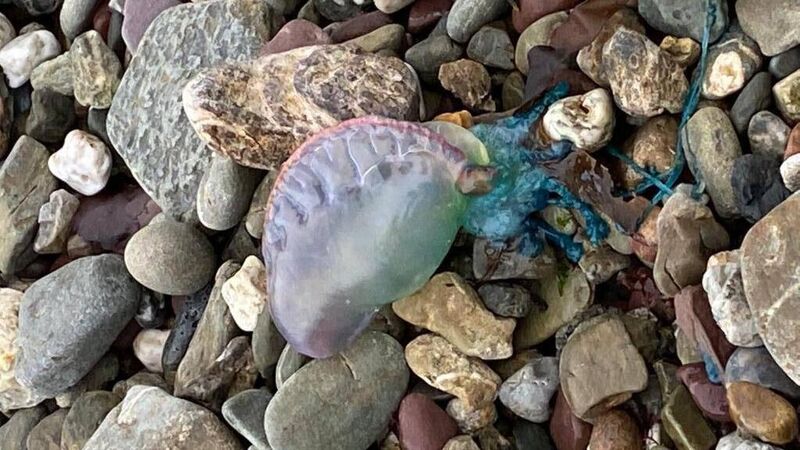Warning issued as dozens of venomous jellyfish spotted on Cork beaches

Portugese man O'war on Ballycrenane beach in East Cork. Picture: Frances Hegarty
Scientists have issued a warning after several Portuguese man o'war jellyfish - one of the most venomous species in the world - washed up on beaches across Cork yesterday and today.
The jellyfish was once an uncommon sight in Irish waters, however, they have been regularly washing up on beaches on Ireland’s south and southwest coasts in recent years.
While most sightings of the creature occur during the summer months, they have been spotted more and more during the months of September, October and November.
UCC Marine biologist Dr Tom Doyle, who is also the co-ordinator of ‘The Big Jellyfish Hunt’ Facebook page said that this year was the fifth consecutive year in which numerous sightings of the creature have been recorded.
He said: “Up to 2016 sightings were very uncommon but since then we’ve had thousands, so we’re seeing something very different here.
"Before that, you had to go back to 1968 to see the sort of numbers we're regularly seeing now."
Dr Doyle said it was hard to say exactly why sigitings have become more common, but he did say that wind was "a major factor."

"These creatures live on the surface of the ocean, and the only way they get around is by using the wind.
“If you get persistent south-westerly windes, as we've had here recently, that can drive up the appearances of the creature
“They come across on the North-Atlantic drift, and if the winds are light, they head south. But if you get strong winds, they get pushed up towards Ireland."
Indeed, according to the ‘Big Jellyfish Hunt’ page, several hundred sightings of the venomous creature have been recorded in Cork in the last two months. 86 sightings were recently reported on one small stretch of Garretstown Beach.
Today alone, 25 sightings were reported on Broadstrand Beach, with a further eight reported close to Rocky Bay.
In actual fact, the Portuguese man o’war is not a true jellyfish, but a 'siphonophore' - a colonial organism made up of many specialized, though genetically distinct, parts.
The man o'war is known for it’s distinct blue/purple colouring and it’s incredibly long tentacles (which can grow up to 165ft long in some cases), which it uses to incapacitate and kill smaller animals and fish.
Its appearance is such that it can appear attractive to pets and small children, to whom a sting could be particularly deadly.
The creatures tend to travel in large groups numbering in the hundreds.
The sting of the creature is known to be excruciatingly painful, and can, in some cases, be fatal to humans.
In the majority of cases, the sting provokes an allergic reaction, causing cardiac distress and difficulty breathing.
If someone is stung by the man o’war, the advice is to remove the attached tentacles with a towel or some sort of covering.
Dr Doyle says the most effective treatment is to apply vinegar and a 'heat-pack' to the affected area, or to submerse the area in warm water to treat the venom already present. If the pain proves to be more than minor, medical assistance should be sought immediately.
- Dr Doyle asked anyone who sees a Portuguese man o’war to photograph it and report its location on the Big Jellyfish Hunt Facebook page.












